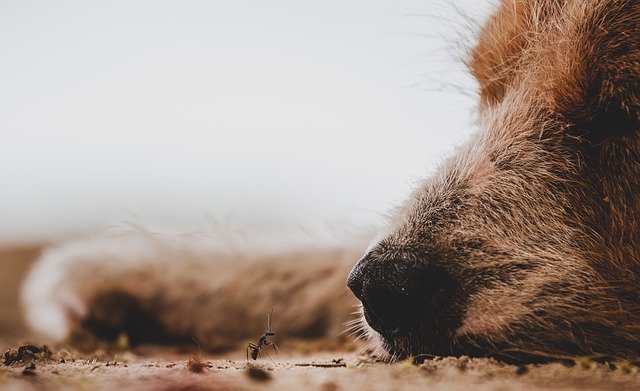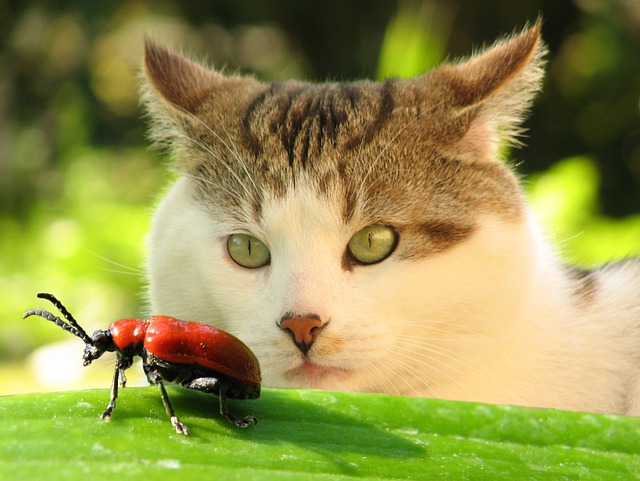How to Treat Insect Bites on Your Pet
Posted: 08/09/2022 | BY: Erin Cain | Categories: Cat , Dog , Pet care
Summer brings plenty of fun opportunities for you and your pet, but it can also bring pests that can make life uncomfortable and even dangerous at times. With the warm weather comes the biting and stinging insects, such as wasps, bees, ticks, mosquitos, flies, and ants. Typically, these pests are annoyances to us and our pets, but sometimes they cause serious allergic reactions. What should you do if your dog or cat gets stung or bit? Here’s how to treat insect bites and stings on your pet so they experience relief as soon as possible.

How can I tell if my pet has an insect bite?
There are a few tell-tale signs that your pet may have suffered a sting or a bite. Look for these symptoms:
- Swelling in a particular area of the body
- Redness around the location of the bite
- Skin that is hot to the touch around the bite
- Vocal sounds (howling and whining)
- Excessive itching
- Holding up a paw or limping
- Drooling
- Hives
Sometimes, pets are stung in hard to see places, such as between the toes or on the bottom of the foot. Take the time to thoroughly brush and look over your pet when she comes in from outside. For those pet parents who live in tick-infested areas, that daily check is a must for both your pet and your family’s health and well-being.

How can you treat insect bites on your dog?
While some insect bites heal without any intervention, others can be more problematic and include long-lasting effects. There are a series of steps to take to treat your dog for her insect bite and make her comfortable as quickly as possible.
1. Look for a stinger within the dog’s wound.
If you locate it, use a stiff and thin item, such as a credit card or ID card, to bring the stinger to the skin’s surface. Pull the stinger out by hand carefully. Avoid using tweezers to remove a stinger, as that may cause more venom to enter your dog’s body.
2. Apply a cold compress.
You can gently press a cold compress or a wrapped ice pack against the injured area to reduce swelling. A bag of frozen corn or peas will work well, too.
3. Create a baking soda and water paste.
Baking soda is a natural anti-inflammatory and an acid neutralizer that relieves the itching associated with an insect bite or sting. Mix two tablespoons of baking soda with a small amount of water and apply the paste to the bite location. Let it dry for a few hours, then rinse.
Avoid using over-the-counter corticosteroids, such as hydrocortisone, without permission from your veterinarian. Many dogs will lick at the applied creams, and while some dogs can tolerate topical steroids, many cannot. Reactions to corticosteroids in dogs can range from abdominal pain to bloody vomit and severe diarrhea.
Steer clear of ammonia products and calamine products as both pose medical problems in dogs. While people can use these treatments, ammonia is toxic to dogs, irritating their mucus membranes. Calamine, which contains zinc oxide, ruptures the red blood cells and can cause gastrointestinal distress and anemia if ingested by a dog.
4. Give your pup an oatmeal bath.
This treatment could be beneficial if your dog were stung or bitten in multiple locations. Oatmeal is very soothing and may bring some much needed relief to your dog.
5. Provide ice water or ice cubes.
Cold ice can be used for any bites or stings inside your dog’s mouth. Because oral pest bites are closer to dogs’ airways, keep a close eye on any swelling that may put pressure on the airways, making it hard for her to breathe.

How should you treat insect bites on your cat?
Insect bites or stings on a cat are often treated similarly to those on dogs. Like their canine counterparts, cats will need to have a stinger gently removed, and a cold compress, baking soda paste, and an oatmeal bath will reduce any mild swelling and discomfort.
For cats, however, especially indoor-outdoor cats, the chances of disturbing a whole wasps’ nest or anthill are high; thus, cats often face multiple bites or stings. Aside from the steps above, here are other points to keep in mind for treating a bite on a cat:
1. Give your cat a dose of oral antihistamine.
Oral antihistamines control allergic reactions. Given a correct dosage, antihistamines can minimize the itch and discomfort of a sting or bite on your cat. Benadryl is the most popular antihistamine, but discuss its use in your cat with your veterinarian before administering. Some cats, especially those on certain medications, should not ingest Benadryl.
2. Observe the cat’s water and food intake.
Make sure your cat is drinking enough water and eating normally after a bite. If your cat was stung on or around the mouth, it might be difficult for her to eat kibble. Soften the dry food with water to make it easier to eat.
3. Use a head cone.
For cats who continually scratch or lick at the wound, the bite area will take much longer to heal. Use a head cone to prevent your cat from reaching the problem spot so it can heal appropriately.
Cats are pros at keeping their injuries and discomforts secret, so double check your cat for bites or stings when he comes inside from an outdoor stroll.

When should I take my pet to the veterinarian for a bug bite?
You should use your best judgment when your pet has been bitten or stung. If your pet has a sudden allergic reaction to a bite, you should immediately take her to the veterinarian or an emergency animal clinic.
Some dogs and cats go into anaphylactic shock because they are severely allergic to the venom from the bug bite. Anaphylaxis is a life-threatening condition because it causes a pet’s face, throat, and airways to swell up so much that it prevents normal respiration. Other emergency signs to look for include:
- weakness or collapse
- difficulty breathing or wheezing
- vomiting
- seizures
- diarrhea
- disorientation or dizziness
- rapid panting
- excessive drooling
- agitation
- Trembling
- severe swelling around the head and neck
If your dog or cat exhibits any of these symptoms after a sting or bite, take them to the veterinarian right away. Without treatment, pets with anaphylaxis can go into cardiac arrest and die.
Some pets have never been bitten or stung, so if this bite is your dog or cat’s first one and you’re unsure if they will have an allergic reaction, take them to the veterinarian just to be safe. Allergic reactions may occur 30 minutes after the bite up to hours later, so always keep a close eye on your pet for the next day after a bug bite to ensure there is no allergic reaction.

Bug bites happen, and pet insurance can help.
Cats are curious, and dogs are explorers, so the probability of your cat or dog suffering a bug bite is reasonably high. However, if your pet has a severe reaction and is rushed to the veterinary hospital, the costs associated with that trip are going to be considerable. With a pet insurance policy for your cat or dog, you won’t have to worry about covering the entire cost of that emergency visit and medications.
Pet insurance is ideal for emergencies that pet parents are not financially prepared to cover. Get a free pet insurance quote for your pet today, so you can be ready for whatever tomorrow brings.
References:
- Stregowski, J. (2020). Common Parasites Found on and In Dogs. Retrieved from https://www.thesprucepets.com/common-parasites-of-the-dog-1117427
- Khalsa, D. (2016). 6 Natural Remedies For Your Itchy Dog. Retrieved from https://www.dogsnaturallymagazine.com/the-itch-fix-heal-your-dog-itching/
- Lee, J. (n.d.). TOPICAL TOXINS — ONE TUBE CAN KILL. Retrieved from https://vetgirlontherun.comhttps://media.petinsurancereview.com/2014/06/TopicalointmentspoisonouspetsCVC2014LEE.pdf
- Seaman, G. (2012). * Common Household Chemicals Harming Your Pets, & their Non-Toxic Alternatives. Retrieved from https://learn.eartheasy.com/articles/8-common-household-chemicals-harming-your-pets-their-non-toxic-alternatives/
- Hemopet. (2019). Anti=Inflammatory Cream for Dogs. Retrieved from https://hemopet.org/calendula-dogs-bug-bite-itchy-skin-bug-repellant-itch-relief-cream/
- Kruzer, A. (2021). Benadryl for Cats. Retrieved from https://www.thesprucepets.com/is-benadryl-safe-for-cats-and-dogs-3384905
- First Aid for Pets. (2021). Allergic Reactions in Dogs. Retrieved from https://firstaidforpets.net/allergic-reactions-in-dogs/
- Grognet, J. (2016). Types of Allergic Reactions in Dogs. Retrieved from https://www.akc.org/expert-advice/health/types-of-allergic-reactions-in-dogs/
Disclaimer
The information contained on this blog is intended for informational and educational purposes only and should not be construed as medical advice. It is not a substitute for professional veterinary care. Always consult with your veterinarian before making any changes to your pet's health care or treatment plan.
The authors of this blog are not veterinarians and do not claim to be experts in pet health. The information provided here is based on our own experiences and research, as well as information from reputable sources. However, we cannot guarantee the accuracy or completeness of this information.
We encourage you to do your own research and consult with your veterinarian before making any decisions about your pet's health.
Previous post
How to Determine Your Cat’s Scratching StyleNext post
Hazardous Indoor Plants and Your PetCompare top pet insurance providers plans.
Enter your dog’s age in years and months to calculate their age equivalent to human years.
Calculate your dog’s ageEnter your cat’s age in years and months to calculate their age equivalent to human years.
Calculate your cat’s age